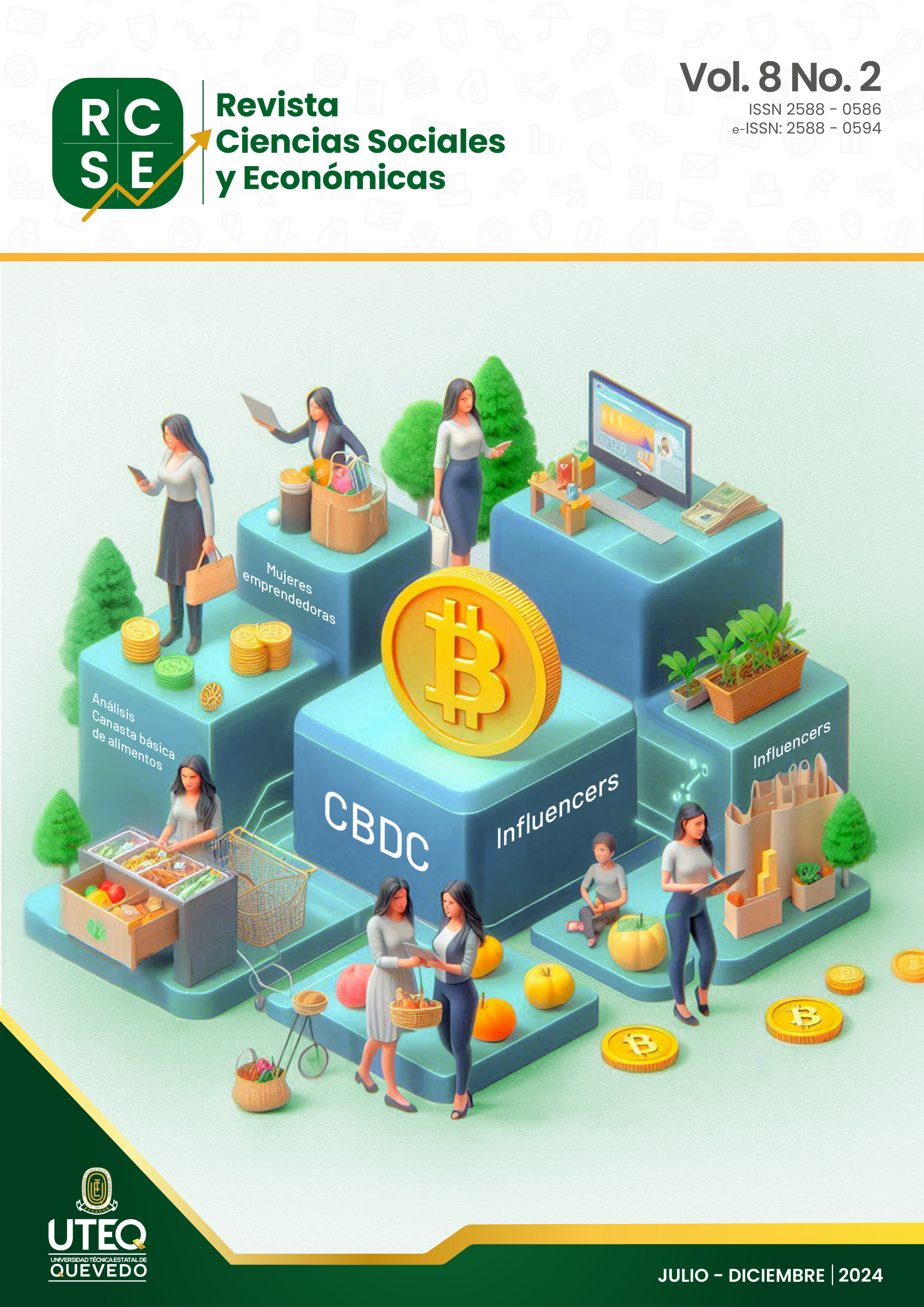Analysis of economic viability and public financing options for african palm production: the case of BanEcuador
DOI:
https://doi.org/10.18779/csye.v8i2.842Keywords:
African oil palm, oil palm, project evaluation, economic feasibility, public financingAbstract
Project evaluation constitutes one of the most useful financial tools for those people who decide to implement their investment idea. To evaluate the economic viability of commercial African palm production in northern Ecuador (Esmeraldas province), an investment proposal was formulated and evaluated according to the investment project methodology. The information for the analysis was obtained in 2021, the year the activities began, the duration of the project was 15 years. This includes analysis of commercial, technical, financial and economic viability, taking into account the 100% financing structure by BanEcuador BP. In addition, a sensitivity analysis of four independent variables was carried out and their impact in the pessimistic and optimistic scenarios on the base scenario on the behavior of profitability indicators: NPV, IRR. The results under certainty and estimated calculations obtained a NPV of $ 1,676,374.48, an IRR of 17%, a PR of 8.4, a R B/C of 3.82, calculations that were developed with 6.22 % of WACC. As a result, in uncertain situations and pessimistic scenarios, the project continues to be successful in the majority of variables analyzed. Based on these findings, it is concluded that the project is effective and its implementation is recommended, as it demonstrates resilience, even in uncertain and adverse circumstances.
Downloads
References
Alvarado, A., Escobar, R. y Henry, J. (2013). El híbrido OxG Amazon: una alternativa para regiones afectadas por Pudrición del cogollo en palma de aceite Palmas, 34(1), 305-314. https://publicaciones.fedepalma.org/index.php/palmas/article/view/10689
Banco Mundial. (2021). El financiamiento de USD 157 000 millones proporcionado por el Grupo Banco Mundial debido a la pandemia constituye la respuesta de mayor envergadura en la historia de la entidad ante una crisis. https://www.bancomundial.org/es/news/press-release/2021/07/19/world-bank-group-s-157-billion-pandemic-surge-is-largest-crisis-response-in-its-history
Camacho, S., Castrejón, D., Pineda, O. y Silva , D. (2022). Impactos de la palma africana en Ecuador [Archivo PDF]. https://poderlatam.org/wp-content/uploads/2022/07/Informe_TOA.pdf
Colina, A., Urdaneta, F. y Portillo, E. (2022). Sistema agroalimentario de la palma aceitera del Sur del Lago de Maracaibo. I. Análisis del entorno. Revista de Ciencias Sociales (Ve), 28(3). https://www.redalyc.org/journal/280/28071865029/html/
Carranza, W., Angulo , M., Cedeño , G. y Prado , Y. (2020). Evaluación socioeconómica del cultivo de cacao (Theobroma cacao L.) en la zona norte de la Provincia de los Ríos. Revista de estudios empresariales y empresariales, 4(2), 96-106. https://journalbusinesses.com/index.php/revista/article/view/79
Fletes , H., Rangel, F., Velas, A. y Ocampo, G. (2013). Pequeños productores, reestructuración y expansión de la palma africana en Chiapas. Región y sociedad, 25(57), 203-239. https://www.scielo.org.mx/scielo.php?script=sci_arttext&pid=S1870-39252013000200007
Fontalvo Gómez, M., Vecino Pérez, R. y Barrios Sarmiento, A. (2014). El aceite de palma africana elae guineensis: Alternativa de recurso energético para la producción de biodiesel en Colombia y su impacto ambiental. PROSPECTIVA, 12(1), 90-98. https://www.redalyc.org/articulo.oa?id=496250639011
Instituto Nacional de Estadística y Censos. (2022). Encuesta de Superficie y Producción Agropecuaria Continua ESPAC 2022.[Archivo PDF]. https://www.ecuadorencifras.gob.ec/documentos/web-inec/Estadisticas_agropecuarias/espac/espac_2022/PPT_%20ESPAC_%202022_04.pdf
INIAP. (s.f). Palma Africana. Instituto Nacional de Investigaciones Agropecuarias. https://www.iniap.gob.ec/palma-africana/
Ivanova , Y., Tristán , M., Romero, M., Charry , A., Lema , S., Choy , J., Vélez , A., Castro , A. y Quintero , M. (2020). Hacia una cadena de palma aceitera que contribuya a la conservación de bosques y reducción de gases de efecto invernadero. https://cgspace.cgiar.org/handle/10568/109750
Kumar, K. (2016). El aceite de palma en el mercado global y sus oportunidades en Estados Unidos. Palmas, 37(2), 319-321. https://fedepalma.org/conferenciainternacional/wp-content/uploads/2022/09/M_3_18_-El-aceite-de-palma-en-el-mercado-global.pdf
López , P., Quiñonez , B., Salinas , I. y Velasco , Á. (2023). Análisis de la rentabilidad de la producción de Sacha Inchi frente a la producción de palma africana en el Cantón La Concordia. Polo del Conocimiento: Revista científico - profesional, 8(4), 874-885. https://polodelconocimiento.com/ojs/index.php/es/article/view/5473
Mena, M. (2020). Indonesia y Malasia concentran el 84% de la producción mundial de aceite de palma. https://es.statista.com/grafico/23123/cantidad-de-aceite-de-palma-producido-por-pais/
Organización de las Naciones Unidas para la Agricultura y la Alimentación. (2022). Statistical Yearbook World Food and Agriculture 2022 . https://www.fao.org/3/cc2211en/online/cc2211en.html
Parra , A. (2013). Valoración de empresas: métodos de valoración. Contexto, 2(1), 84-100. https://revistas.ugca.edu.co/index.php/contexto/article/view/44
Perea-Gómez, L., García-Salazar, J., López-Reyna, M. y Arellano-Ostoa, G. (2022). Evaluación financiera de la producción in vitro de árboles de olivo con opciones reales. Madera y bosques, 28(3). https://doi.org/10.21829/myb.2022.2832380
Tapia , M. y Alvarado , F. (2018). Análisis correlacional entre la producción del aceite de palma, sus exportaciones y su contribución al PIB agrícola durante el período 2010 - 2017. Dominio de las Ciencias, 4(4), 270-283. https://doi.org/10.23857/dc.v4i4.840
Torres , E. (2016). Comportamiento del híbrido interespecífico OxG, Coari x La Mé en Palmeras del Ecuador. Palmas, 37(1), 294-298. https://publicaciones.fedepalma.org/index.php/palmas/article/view/11913
Vegas, A., Ortega , D., Gualoto, W., Paredes, E., Rebolledo, E., Quintero, L. y Ortega, J. (2016). Respuesta de la palma Africana híbrido INIAP-Tenera cultivada in vitro según el tipo de explante y niveles de ácido naftalenacético. Bioagro, 28(3), 193-200. http://ve.scielo.org/scielo.php?script=sci_arttext&pid=S1316-33612016000300006&lng=es&tlng=es
Zambrano , T. (2023). Incidencia de la plaga pudrición del cogollo en las exportaciones ecuatorianas de aceite de palma africana, periodo 2018–2021 [Tesis de maestría, Universidad Politécnica Salesiana]. Universidad Politécnica Salesiana. https://dspace.ups.edu.ec/handle/123456789/26542
Published
How to Cite
Issue
Section
License
Copyright (c) 2024 César Geovanny Ortiz Mosquera, Jorge Joffre Miranda Mejía, Ronald Adriano Paita Ríos, Ximena Minshely Guillín Llano

This work is licensed under a Creative Commons Attribution-NonCommercial-ShareAlike 4.0 International License.
Licensing Agreement
This journal provides free access to its content through its website following the principle that making research available free of charge to the public supports a larger exchange of global knowledge.
Web content of the journal is distributed under a Attribution-NonCommercial-ShareAlike 4.0 International.
Authors may adopt other non-exclusive license agreements for the distribution of the version of the published work, provided that the initial publication in this journal is indicated. Authors are allowed and recommended to disseminate their work through the internet before and during the submission process, which can produce interesting exchanges and increase citations of the published work.



